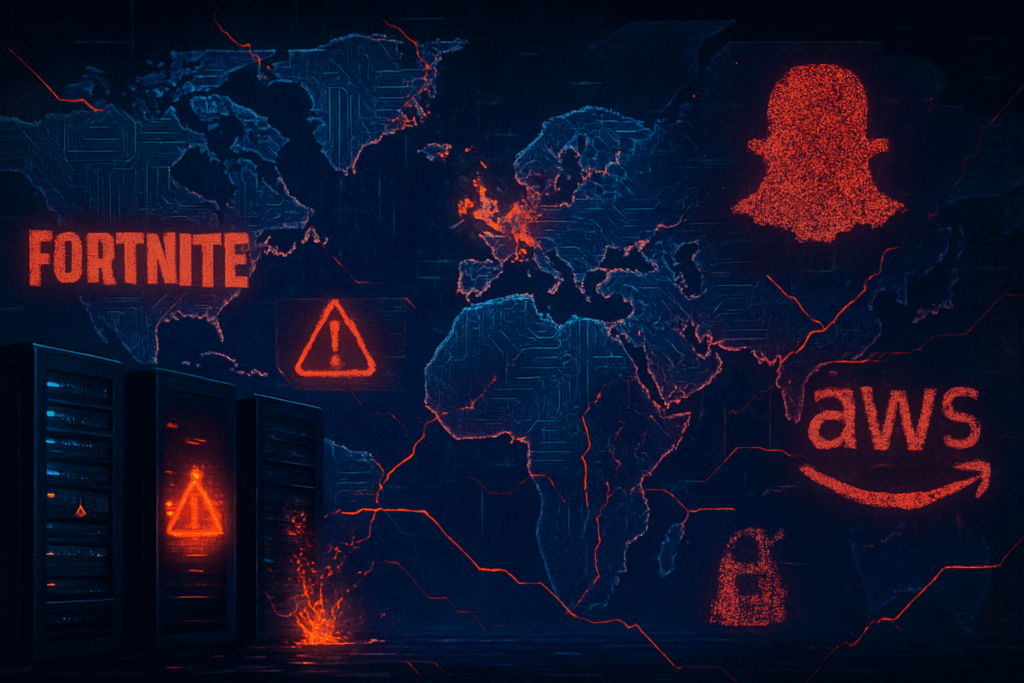
October 20, 2025 – The digital world experienced a jarring halt today as Amazon Web Services (AWS), the backbone of countless internet services, suffered a massive global outage. The disruption, primarily affecting its critical US-EAST-1 region in Northern Virginia, brought down an extensive array of popular platforms, including gaming giant Fortnite, social media powerhouse Snapchat (NYSE: SNAP), and even Amazon's (NASDAQ: AMZN) own sprawling e-commerce and smart home ecosystem. Millions of users worldwide found themselves locked out of essential services, underscoring the profound and sometimes precarious reliance of modern society on a handful of colossal cloud infrastructure providers.
This widespread incident serves as a stark reminder of the interconnectedness of the internet and the cascading effects when a central component falters. While AWS engineers worked frantically to restore services, the outage highlighted vulnerabilities in cloud-centric architectures and reignited discussions about redundancy, resilience, and the concentration of digital power. The immediate significance lies not just in the temporary inconvenience but in the ripple effect across industries, impacting everything from communication and entertainment to finance and enterprise operations.
The Technical Fallout: A Deep Dive into AWS's Unprecedented Glitch
The genesis of today's extensive disruption was traced back to an underlying internal subsystem within AWS responsible for monitoring the health of its network load balancers. Initial reports surfaced shortly after midnight Pacific Time, around 3:11 AM ET, indicating elevated error rates and latencies, particularly impacting Amazon DynamoDB, a crucial NoSQL database service. This initial hiccup quickly escalated, with more than 90 AWS services eventually exhibiting degraded performance, including foundational components like Elastic Compute Cloud (EC2) for virtual machines and Simple Storage Service (S3), which underpins vast swathes of internet data storage.
AWS's Service Health Dashboard became the focal point for anxious developers and users, confirming a problem "related to DNS resolution of the DynamoDB API endpoint in US-EAST-1." While Amazon clarified that the incident was a technical fault and not the result of a cyberattack, the cascading nature of the failure demonstrated how a single point of failure, even in a highly distributed system, can have catastrophic consequences. The complexity of modern cloud infrastructure means that issues in one service can rapidly propagate, leading to widespread unavailability across seemingly unrelated applications.
The recovery process began around 5:27 AM ET, with AWS reporting significant progress by 6:35 AM ET, stating the underlying DNS issue was "fully mitigated." However, a complete return to normalcy was a prolonged effort, extending into the afternoon for many affected platforms. The incident differed from typical, localized outages due to its broad impact across core AWS services and its critical US-EAST-1 region, which is a primary host for a vast percentage of internet traffic and applications. The initial reactions from the AI research community and industry experts immediately pointed to the need for even more robust multi-region and multi-cloud strategies to mitigate such risks.
Competitive Ripples: Impact on Tech Giants and the Cloud Landscape
The AWS outage had immediate and far-reaching implications for a multitude of companies, both large and small, that rely on its infrastructure. Beyond Fortnite and Snapchat (NYSE: SNAP), major platforms like Roblox (NYSE: RBLX), Signal, Reddit (NYSE: RDDT), Coinbase Global, Inc. (NASDAQ: COIN), Venmo, Robinhood Markets, Inc. (NASDAQ: HOOD), Canva, and Duolingo all reported significant service interruptions. Even Amazon's (NASDAQ: AMZN) own ecosystem, including Alexa, Prime Video, Ring doorbell cameras, and its main shopping website, was not immune, highlighting the deep integration of AWS into its parent company's operations.
While no company benefits directly from such an outage, this event could subtly shift competitive dynamics in the cloud computing market. Competitors like Microsoft (NASDAQ: MSFT) Azure and Google (NASDAQ: GOOGL) Cloud Platform might see increased scrutiny from enterprises considering diversifying their cloud providers or implementing more robust multi-cloud strategies. For major AI labs and tech companies, the disruption underscores the critical need for resilient infrastructure, especially as AI models become more computationally intensive and require constant, uninterrupted access to data and processing power.
The incident could accelerate a trend towards distributed architectures that are less dependent on a single cloud region or provider. Startups, often built entirely on a single cloud platform for cost-effectiveness, face the most immediate disruption and potential reputational damage. This event reinforces the market positioning of robust, highly available infrastructure as a premium feature and could lead to increased investment in hybrid cloud solutions that offer greater control and redundancy, mitigating the risk of a single-provider failure.
Wider Significance: The Fragility of Our Digital World
This massive AWS outage fits squarely into the broader AI landscape and trends by exposing the foundational vulnerabilities upon which much of the modern AI ecosystem is built. From large language models requiring massive computational resources to AI-powered applications processing real-time data, the underlying cloud infrastructure is paramount. When that infrastructure falters, the AI applications built atop it become unusable, demonstrating that even the most advanced AI is only as reliable as its lowest-level dependencies.
The impacts extend beyond mere inconvenience; economic productivity suffers, critical communications are interrupted, and consumer trust in always-on digital services can erode. For AI, specifically, this means delays in training new models, interruptions in AI-driven automation, and a general slowdown in operations for businesses leveraging AI solutions. Potential concerns include the over-reliance on a few dominant cloud providers, which creates systemic risk. A major outage can trigger a domino effect across industries, posing questions about digital sovereignty and the concentration of power in the hands of a few tech giants.
Comparisons to previous AI milestones and breakthroughs often focus on algorithmic advancements or hardware innovations. However, this outage highlights that infrastructure reliability is as critical as algorithmic prowess. Without stable, high-performance cloud environments, even the most revolutionary AI models remain theoretical. It serves as a stark reminder that the "AI revolution" is deeply intertwined with the "cloud revolution," and the resilience of the latter directly dictates the progress and stability of the former.
Future Developments: Building a More Resilient Digital Future
In the wake of this significant outage, several near-term and long-term developments are expected. Immediately, AWS will undoubtedly conduct a thorough post-mortem analysis, which is crucial for identifying precise root causes and implementing preventative measures. This will likely lead to enhanced internal monitoring systems, improved redundancy within critical services like DynamoDB and network load balancers, and potentially more granular controls for customers to manage their own service dependencies.
Looking ahead, experts predict an accelerated shift towards more distributed and resilient architectures. This includes wider adoption of multi-cloud strategies, where organizations spread their workloads across different cloud providers to avoid single points of failure. Hybrid cloud models, combining on-premise infrastructure with public cloud services, may also gain renewed interest. Potential applications and use cases on the horizon include the development of more sophisticated, AI-driven incident response systems that can predict and mitigate outages before they become widespread.
The primary challenges that need to be addressed involve the complexity of implementing multi-cloud strategies, the cost implications, and the need for standardized tools and practices across different cloud environments. Experts predict that cloud providers will invest heavily in further regional isolation and fault tolerance, while enterprises will increasingly prioritize infrastructure resilience as a key performance indicator. What to watch for next includes AWS's official post-mortem, which will provide critical insights, and how major enterprises react by adjusting their cloud adoption strategies in the coming weeks and months.
Comprehensive Wrap-up: A Call for Digital Resilience
Today's massive AWS outage serves as a profound and timely reminder of the fragility inherent in our increasingly cloud-dependent digital world. The key takeaways are clear: even the most robust infrastructure can fail, the interconnectedness of services means local issues can have global repercussions, and the concentration of critical services in a few major cloud providers presents systemic risks. The incident's significance in AI history lies not in an AI breakthrough, but in highlighting the essential, often overlooked, foundational layer upon which all AI innovation rests.
This development underscores the critical importance of digital resilience for every organization, from tech giants to emerging startups. It necessitates a re-evaluation of disaster recovery plans, an increased focus on multi-region and multi-cloud deployments, and a deeper understanding of service dependencies. The long-term impact will likely be a more diversified and robust cloud ecosystem, driven by both provider enhancements and customer demand for greater fault tolerance.
In the coming weeks and months, watch for AWS's detailed technical post-mortem and the subsequent industry-wide discussions and policy considerations around cloud reliability and concentration risk. This event will undoubtedly serve as a catalyst for renewed investment in resilient infrastructure and distributed architectures, shaping the future of how we build and deploy AI and all other digital services.
This content is intended for informational purposes only and represents analysis of current AI developments.
TokenRing AI delivers enterprise-grade solutions for multi-agent AI workflow orchestration, AI-powered development tools, and seamless remote collaboration platforms.
For more information, visit https://www.tokenring.ai/.





